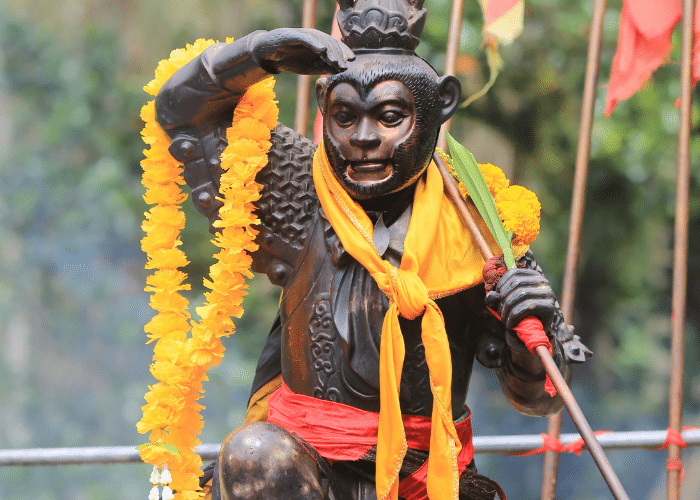Sun Wukong, also known as the Monkey King, is a legendary figure from the 16th-century Chinese novel Journey to the West (西遊記), written by Wu Cheng’en. His story is deeply rooted in Chinese mythology, folklore, and religious traditions, particularly Buddhism and Daoism.
Origins and Early Life
Sun Wukong was born from a magical stone on the Mountain of Flowers and Fruit (Huāguǒ Shān). This stone had absorbed the essence of heaven and earth, granting him extraordinary abilities from birth. After emerging from the stone, Wukong quickly became the king of a group of monkeys by demonstrating his bravery and strength.

The Quest for Immortality and Supernatural Powers
Unsatisfied with his mortal existence, Wukong sought immortality. He trained under the Daoist master Subhuti (Puti Patriarch), who taught him powerful spells, including the 72 Transformations, which allowed him to shape-shift into different beings and objects. He also learned how to travel vast distances quickly using the Cloud Somersault (Jīndǒuyún) technique.
Through his cunning and determination, Wukong stole the Golden-Banded Staff (Ruyi Jingu Bang) from the Dragon King of the Eastern Sea. This staff could change size at his command, allowing him to use it as both a weapon and a tiny needle he could hide behind his ear.
Wukong’s growing power led him to challenge the Heavens. He declared himself “The Great Sage, Equal to Heaven” (Qítiān Dàshèng) and demanded recognition from the celestial realm.
Rebellion Against Heaven
Despite his arrogance, the Jade Emperor attempted to appease Sun Wukong by giving him minor heavenly positions, such as the Keeper of the Heavenly Horses. However, when Wukong realized he was being mocked, he rebelled.
He rampaged through Heaven, defeating celestial armies, consuming the Peaches of Immortality, stealing the Elixir of Life, and causing chaos in the celestial courts. Eventually, the Buddha himself intervened, trapping Wukong under a magical mountain (Five Elements Mountain) for 500 years as punishment.
Journey to the West
Wukong was eventually freed by the bodhisattva Guanyin under the condition that he serve Tang Sanzang (Tripitaka), a Buddhist monk on a pilgrimage to India to retrieve sacred scriptures. This journey, filled with battles against demons and trials of character, was Wukong’s path to redemption.
Over time, he learned discipline, compassion, and humility, shedding his rebellious nature. By the end of the journey, he achieved enlightenment and was granted Buddhahood, earning the title “Victorious Fighting Buddha” (Dòu Zhànshèng Fó).
Legacy and Cultural Impact
Sun Wukong remains one of the most iconic characters in Chinese mythology. His story has influenced literature, opera, film, and even modern media, including anime, video games, and comics. He is often seen as a symbol of rebellion, perseverance, and redemption.



